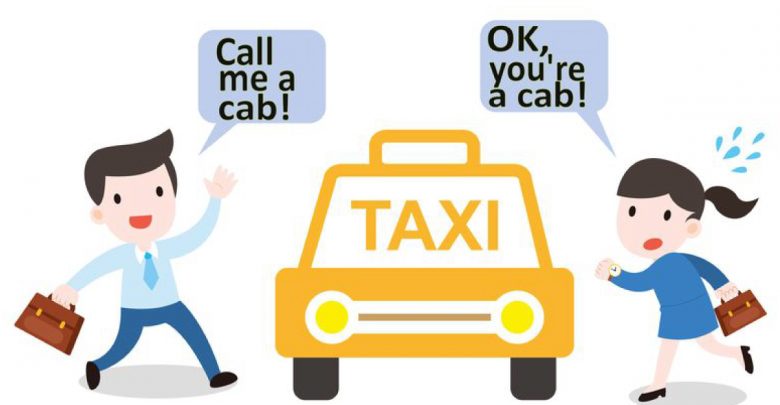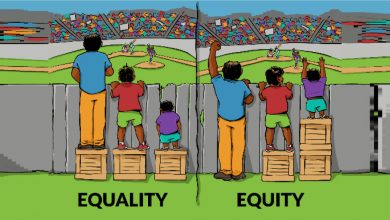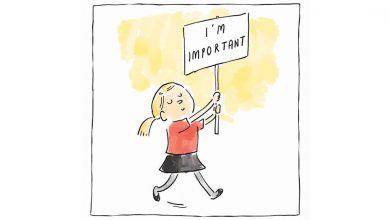7 ways to deal with ambiguity in a training context
What exactly is "ambiguity"? Is it a good thing, or a bad thing? Why does it seem that we automatically run away from ambiguity and uncertainty? Is there a way to get better at handling ambiguity? How can we constructively handle ambiguous situations in a training set? Is it possible to get so good at it that the results become better than they would have been if there was no ambiguity to begin with? These questions and more are addressed in this article and taking a look at what ambiguity is, what it is to us, and what we can do about it.

Why did I choose this tool? I like this tool because it takes a pragmatic approach of actually working to reduce the ambiguity rather than wallowing in it, and I find that to be helpful while there is a different way of looking at the topic of ambiguity. I don’t think that exploring in too much depth the concept of ambiguity itself would be as helpful as understanding how we can actually handle ambiguity in a training setting.
How does this apply to being a trainer? Being a trainer in non-formal education is inevitably ambiguous. We are constantly encountering new people who have certain expectations from us (that we may or may not know about) and are trying to lead them to good learning outcomes, oftentimes without even fully knowing where they are already at, what exactly they need and what will inspire them or trigger them in a negative way. As such, we constantly need to make decisions without having all of the information, and this is exactly what many companies refer to as being one of the main qualities of those who are “experts” at dealing with ambiguity. But are we all experts at it? Or does ambiguity and uncertainty still give us the jitters and cause us to either jump too fast to conclusions (to end the ambiguity) or stop caring about the outcomes and just go along with it all (wallowing in the ambiguity)? Or have we found that sweet spot of being able to handle just the right amount of ambiguity needed to achieve a high-quality result? This article and the subsequent self-reflection questions may provide some insight on this.
Main content:
Cambridge dictionary has a few seemingly different meanings of ambiguity.
A situation or statement that is unclear because it can be understood in more than one way. An example of this is:
[ C ] This is a first step toward clarifying things, but there are still many ambiguities.
A situation in which something has more than one possible meaning and may, therefore, cause confusion. An example of this is:
We wish to remove any ambiguity concerning our demands.
There are still some ambiguities in the contract.
ambiguity about something: You need to clear up any ambiguity about the agency’s fundamental purpose.
The common thread in all of these meanings seems to be a lack of clarity and uncertainty. Clarity is power, but there will inevitably be times where things won’t be as clear as we would want them to be, and where we will lack certainty about what is going on and/or what we should do about it.
There has been a lot of discussion about ambiguity lately, both in the corporate world and in the training world. All of this “touting of ambiguity” can be understood to mean that ambiguity in itself is something good and something that we should all be happy with. And some people may feel this way.
My take on it is a bit different. I definitely think that ambiguity is inevitable, particularly in non-formal education. It is the price that we need to pay to be more open, less rigid, and more creative than perhaps the more traditional education systems. And all of these are good things, and yet which do bring along with them a certain level of ambiguity.
This doesn’t mean that ambiguity in itself is a good thing, and it is something that can be misused or get out of hand if it is not dealt with properly. However, the ability to constructively handle ambiguity and bring an ambiguous situation to a positive outcome is an excellent skill to have, and one that will enable you to facilitate trainings and workshops that are open, flexible, creative, and have all of these above mentioned great elements in them.
For this reason, most of the “ways of dealing with ambiguity” mentioned in this article are actually ways of reducing the ambiguity. If you can reduce it to a manageable form, you have a better chance of achieving a positive outcome then if you let the ambiguity take a life of its own and don’t care about the outcomes.
Ambiguity and uncertainty bring with them a certain level of discomfort, and that’s the reason why a lot of people would prefer to avoid it even in cases when it could lead to a better result than could have been otherwise achieved. For example, if you settle for a life partner that you don’t really love because you don’t want to face an uncertain future. Or if you settle for a job that you know is not the best for you because you want the safety that it brings. Or when you conduct training in the same way you always have, even though there are elements you could change or adapt to make it more effective.
It is possible to train yourself to become more and more comfortable with being in ambiguity. It’s like having some pain when you’re working out. No one likes pain just for the sake of it, but when you know that pain will get you the result you are after you can learn to endure it (and maybe even enjoy it) because of the end result it will bring.
This is my take on ambiguity, followed by some concrete steps of how you can handle ambiguity in a training setting.
7 Ways to Deal with Ambiguity in a training setting
“Accepting that the world is full of uncertainty and ambiguity does not and should not stop people from being pretty sure about a lot of things.” – Julian Baggini
1. Assess your own ambiguity tolerance and reactions, and work on expanding your abilities
Start with yourself, because however you are feeling during ambiguous times, participants will pick up on and be affected by. If you find ambiguity scary and you can’t handle it very well, acknowledge that and find a way to expand your skills. There are small things that you can do to become more comfortable with ambiguity in a safe environment, like trying to make a new meal or attending a seminar that is unrelated to your field of expertise. It’s about being ok with not knowing everything and adapting your approach as you increase your level of knowledge. Like exercise, you can build your skills step by step and pretty soon you’ll find yourself being comfortable in situations you would previously freak out in. Of course, if you must freak out don’t do it in front of the participants 😉. When things get ambiguous in training, nothing will calm and inspire your participants then your confidence and stability, even when you don’t have all the answers.
2. Be Crystal Clear on What is Clear
It’s very important to have a clear premise and framework to manage ambiguity effectively. For instance, if nothing else at least the goals of the training should be clear to participants and trainers, and the general approach and methodology that will be used. Share as much information as is relevant to the participants, and don’t intentionally keep them in ambiguity as this can cause unnecessary stress and problems. If you can’t give them the information that they want, be clear about this and tell them when and how they can have that information. If you need to keep them in ambiguity for a certain session/exercise to be effective, make this clear as well and let them know that they’ll understand all in the debriefing (or whenever you will make the clarifications that they are looking for). Some ambiguity can be useful for the training process especially in non-formal education, but only if it is used cautiously, intentionally and when there is a planned “light at the end of the dark ambiguous tunnel”.
3. Acknowledge what you know and what you don’t know
Don’t be afraid to say “I don’t know”, and perhaps ask if participants might have the answer to that particular issue. As a trainer, you aren’t expected to be an expert in everything. But be clear on what your area of knowledge/expertise is so that participants can know what kind of information they can expect from you. Don’t be too humble and pretend like you don’t know anything, as this can make participants feel uncomfortable and/or decrease their trust in you as a trainer (when you are merely a facilitator it’s a different story, your knowledge will extend then to facilitating group processes rather than knowledge specific to the training content). To have a clear idea of what you know, it might be useful to do a self-assessment once in a while. What experiences have you had, what books have you read, what formal or informal training have you received? Don’t limit your knowledge base to only what you have a master’s degree in, knowledge gained through informal or non-formal means is also extremely valuable so acknowledge it as such.
4. Don’t Waffle
Have you ever been in a training where the trainer seemed like they were always talking to themselves and trying to figure out what they were doing on the go? It’s a very strange and frustrating position to be in as a participant (maybe I will say this, maybe I don’t, maybe we should do this, or maybe we should do that instead, do we have time for this or that?). The trainer should figure out before the session (preferably before the training) what the objective of that particular session is, and how they plan to get there. If there is a need for change along the way, it is best to change it swiftly and not let the participants know. This is not so that you can come across as perfect, but so that the participants can feel confident in the training and trainer and not like they need to worry about where it is all going, which can actually hinder the learning process. If there is a need to inform participants (for example if they were told that there would be a certain session but plans have changed) inform them clearly and include the reason for it so that they maintain the confidence that their training experience is in good hands.
5. Encourage Risk-Taking
What would that mean in a training setting? It might mean not shutting down a topic too soon because it seems “too risky” or controversial. It might mean trying a different approach or method that you are not yet comfortable with, but which might have the potential to get good results. It might mean stepping in and saying what you think when it’s more comfortable to be the “neutral” trainer in the background. It might mean allowing your emotions on a certain topic to come through, or allowing others to express their emotions on it. There are a multitude of opportunities to take risks and to achieve potentially better results than would have been achieved if that risk hadn’t been taken. Of course, randomly taking risks just for the sake of it isn’t what we are talking about, but rather taking risks for a purpose, even if that purpose is merely to deepen the training experience or for you as a trainer to learn something new.
“The quality of your life (or of your training) is determined by the amount of uncertainty (ambiguity) you can comfortably handle.” – Tony Robbins
6. Envision Alternative Scenarios
Envisioning alternative scenarios only works if you have a specific situation to deal with. For example, say you have a difficult participant in your training and you are deciding what to do about it. You will probably a) choose to talk to the participant directly or b) ignore the issue and hope it goes away. If you choose to talk to the participant directly, one of 4 things will likely happen a) they will listen and adapt their behavior accordingly or b) they will become more difficult and perhaps aggressive as a result of being “reprimanded” or c) they will withdraw completely and stop actively participating or d) they will decide to leave the training setting. Analyzing the situation, coming up with different scenarios and preparing for all of the potential outcomes of the path you decide to take is a way to minimize the ambiguity of the situation. It also allows you to proceed with confidence in spite of the fact that it is uncertain what will happen next, knowing that you are prepared for any of the potential outcomes.
7. Engage Other People and Perspectives
This one is especially useful if you feel stuck or at a stalemate with your immediate team of trainers about what to do. Talk about it with other people you trust that are not in the situation, not to support your stance (doing that naturally wouldn’t really help anyone) but rather to get an outside perspective that might help you to see more clearly. Getting outside perspectives can be very useful, but the final decision must be made by those involved as they will have the responsibility to carry out the decision and deal with the outcomes.
Reflection questions:
What is the main experience that comes to mind when you think of an “ambiguous situation in a training setting”?
How did you handle it?
Were you satisfied with the results?
On a level of 1-10, how comfortable are you with dealing with ambiguity in trainings?
How can you improve this number?
On a level of 1-10, how comfortable are you with dealing with ambiguity in everyday life?
How can you improve this number?
When you think of ambiguity, what comes to mind (uncertainty, confusion, panic, excitement, learning….)?
If it’s something negative, how about changing the meaning to something more positive to make it easier to handle?
Exercise
The next time you experience an uncomfortable level of ambiguity in a training setting (or any setting), go through the above-mentioned steps and write notes about the situation, what actions and steps you take, and the results. This will help you the next time you face a similar situation to have a kind of personalized guide to help you navigate it successfully.





